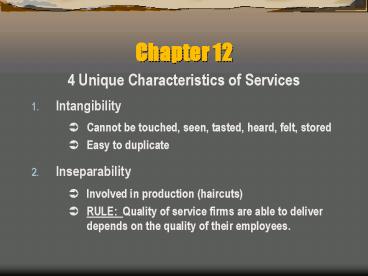4 Unique Characteristics of Services - PowerPoint PPT Presentation
1 / 12
Title:
4 Unique Characteristics of Services
Description:
... heard, felt, stored. Easy to duplicate. Inseparability. Involved in production (haircuts) ... RULE: Quality of service firms are able to deliver depends on ... – PowerPoint PPT presentation
Number of Views:119
Avg rating:3.0/5.0
Title: 4 Unique Characteristics of Services
1
Chapter 12
- 4 Unique Characteristics of Services
- Intangibility
- Cannot be touched, seen, tasted, heard, felt,
stored - Easy to duplicate
- Inseparability
- Involved in production (haircuts)
- RULE Quality of service firms are able to
deliver depends on the quality of their employees.
2
Chapter 12
- 4 Unique Characteristics of Services
- 3. Heterogeneity
- Physicians in a practice
- Seeks to be standardized and uniform by training,
preparation procedures and process mechanization - 4. Perishability
- Services cannot be stored, warehoused or
inventoried - Objective 1 Synchronize Demand
- Objective 2 Encourage Demand During Offpeak
Times
3
Chapter 12
- (P. 375)
- Service Quality 5 Components
- Reliability ability to perform (get it right
the first time) - Responsiveness ability to provide prompt
service (quick call backs) - Assurance knowledge, courtesy and trustworthy
(treated with respect) - Empathy caring (listening)
- Tangibles physical evidence (facilities, tools,
appearance)
4
Chapter 12
- (P. 376, Exh. 12.2)
- Gap Model of Service Quality
- 5 Gaps you dont want them
- Services Marketing in Manufacturing
- A competitive advantage for companies who make
things by providing service for their customers /
users. - Product Strategy 3 types of Processing
- People Processing
- Possession Processing
- Information Processing
5
Chapter 12
- (P. 380)
- Distribution Strategy Issues
- Convenience
- Number of outlets
- Distribute directly / indirectly
- Location of services
- Scheduling
6
Chapter 12
- (P. 381)
- Promotion Strategy Issues
- Stress tangible cues
- Use personal information sources
- Create a strong organizational image
- Engage in post-purchase communication
7
Chapter 12
- (P. 381-382)
- Price Strategy Issues
- Define the unit of service consumption paid for
action or paid for time - Bundling or separately pay for what is used
- Pricing objectives
- Revenueoriented prices surplus over cost
- Operationsoriented prices peak / slow
- Patronage-oriented prices maximize customers
8
Chapter 12
- Relationship Marketing Levels
- Financial
- Financial, Social
- Financial, Social, Structural
9
Chapter 12
- Internal Marketing
- Treat employees as customers
- Competing for talent
- Offer a vision
- Train employees
- Stress teamwork
- Give employees more freedom to make decisions
- Measure and reward good service performance
- Know employee needs
10
Chapter 12
- What Makes Nonprofit Marketing Unique?
- Setting of marketing objectives generally not
dollar related - Target markets
- Apathetic or strongly opposed targets
- Pressure to adopt undifferentiated segmented
strategies no average user - Complementary positioning works with other
similar providers
11
Chapter 12
- What Makes Nonprofit Marketing Unique?
- Product Decisions
- Benefit complexity complex, long term,
intangible - Benefit strength weak and indirect benefit of
driving 55 mph - Involvement low to high dont litter, stop
smoking - Distribution Decisions
- Where do people want to perform?
12
Chapter 12
- What Makes Nonprofit Marketing Unique?
- Promotion Decisions
- PSAs
- Licensing Name
- Pricing Decisions
- Pricing objectives cost leveling
- Non-financial prices
- Indirect payment
- Separation between payers and users
- Below cost pricing































